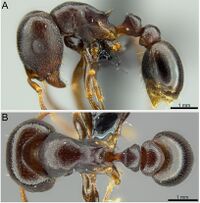Tetramorium lerouxi
| Tetramorium lerouxi | |
|---|---|

| |
| Scientific classification | |
| Kingdom: | Animalia |
| Phylum: | Arthropoda |
| Class: | Insecta |
| Order: | Hymenoptera |
| Family: | Formicidae |
| Subfamily: | Myrmicinae |
| Tribe: | Crematogastrini |
| Genus: | Tetramorium |
| Species group: | solidum |
| Species: | T. lerouxi |
| Binomial name | |
| Tetramorium lerouxi Mbanyana, Robertson & Hita Garcia, 2018 | |
Nothing is known about the biology of Tetramorium lerouxi.
Identification
Mbanyana et al. (2018) - Tetramorium lerouxi is distinguished from all other species of the T. solidum species group by its unique petiolar node, which has posterior, lateral, rounded extentions; in posterior view, the dorsal margin is straight and angulate with respect to the lateral margin.
Keys including this Species
Distribution
Latitudinal Distribution Pattern
Latitudinal Range: -31.46741° to -31.46741°.
| North Temperate |
North Subtropical |
Tropical | South Subtropical |
South Temperate |
- Source: AntMaps
Distribution based on Regional Taxon Lists
Afrotropical Region: South Africa (type locality).
Distribution based on AntMaps
Distribution based on AntWeb specimens
Check data from AntWeb
Countries Occupied
| Number of countries occupied by this species based on AntWiki Regional Taxon Lists. In general, fewer countries occupied indicates a narrower range, while more countries indicates a more widespread species. |

|
Estimated Abundance
| Relative abundance based on number of AntMaps records per species (this species within the purple bar). Fewer records (to the left) indicates a less abundant/encountered species while more records (to the right) indicates more abundant/encountered species. |

|
Biology
Castes
Nomenclature
The following information is derived from Barry Bolton's Online Catalogue of the Ants of the World.
- lerouxi. Tetramorium lerouxi Mbanyana, Robertson & Hita Garcia, 2018: 31, figs. 3D, 15, 24 (w.) SOUTH AFRICA.
Unless otherwise noted the text for the remainder of this section is reported from the publication that includes the original description.
Description
Worker
(N = 2) HL 1.080–1.151 (1.115); HW 1.151–1.210 (1.180); SL 0.767–0.738 (0.752); EL 0.275–0.285 (0.280); PH 0.570–0.580 (0.575); PW 0.713–0.767 (0.740); WL 1.180–1.190 (1.185); PSL 0.207–0.216 (0.211); PTH 0.452–0.462 (0.457); PTL 0.295–0.299 (0.297); PTW 0.446–0.482 (0.464); PPH 0.443–0.452 (0.447); PPL 0.334–0.354 (0.344); PPW 0.572–0.600 (0.586); OI 24 (24); CI 105–107 (106); SI 61–67 (64); DMI 60–65 (62); LMI 48–49 (49); PSLI 18–20 (19); PeNI 63 (63); LPeI 65 (65); DPeI 149–163 (156); PpNI 78–80 (79); LPpI 74–80 (77); DPpI 162–179 (171); PPI 124–128 (126).
Holotype. Mandibles predominantly smooth with fine striations basally. Anterior clypeal margin with extensive and deep indentation. Frontal carinae absent. Eyes with 15 ommatidia in longest row. Propodeal spines long and acute (PSLI 18–20). Metapleural lobes low and rounded. Peduncle with broad keel-shaped subpetiolar process. Petiole in profile nodiform, with anterior face slightly more steeply angled with blunt corners. In dorsal view, petiolar node shaped almost rectangular broadening posteriorly with rounded corners and narrowing anteriorly with prominent blunt corners (Fig. 3D). Postpetiole low and rounded both in dorsal view and in profile. Dorsum of head with fine longitudinal striations. Spaces between striations with very fine reticulate ground sculpture. Dorsal surfaces of mesosoma and petiole with fine reticulate sculpture. Postpetiolar node predominantly smooth, with fine reticulate sculpture in places. Gastral tergite with fine reticulate sculpture. Numerous hairs on anterior clypeal margin. Dorsum of head with two pairs of erect hairs. Dorsum of mesosoma, nodes and first gastral tergite without any erect hairs, with only sparse white pubescence. Ventral surface of head with psammophore. Colour uniformly black.
MISC This species is only known from South Africa, where it has been collected in Melton Wold near Victoria West in the Northern Cape and from Oranjekrag in the Free State.
Type Material
Holotype. South Africa: Northern Cape: worker, Melton Wold, 31.46741° S, 22.721550° E, 1333 m a.s.l., 7 Jan. 2009, N. Mbanyana and H.G. Robertson leg. (SAM-HYM-C023330). South African Museum Paratypes. South Africa: 2 pinned workers, same collection data as for holotype (SAM-HYM-C023329).
Etymology
Named after Dr Jaco Le Roux who supervised and helped with molecular genetic work on the T. solidum group, which helped to confirm the validity of this species.
